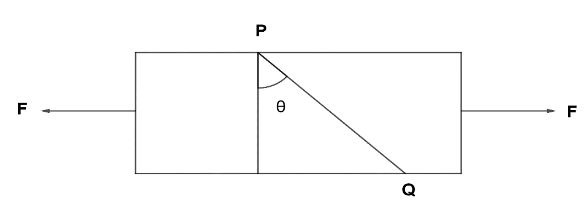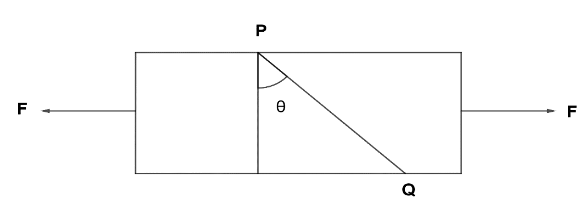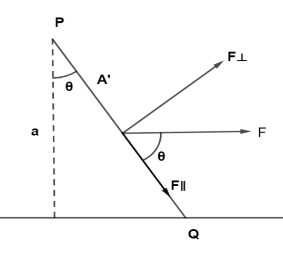
A bar is subjected to equal and opposite forces as shown in the figure. PQ is a plane making an angle θ with the cross-section of the bar. If the area of cross-section is 'a', then what is tensile stress on PQ?

A. $\dfrac{F}{a}$
B. $\dfrac{{F\cos \theta }}{a}$
C. $\dfrac{{F{{\cos }^2}\theta }}{a}$
D. $\dfrac{a}{{F\cos \theta }}$

Answer
486.6k+ views
Hint: This question is from the part about tensile stress. A bar of cross section A is subjected to equal and opposite tensile forces F at its ends. Consider a plane through the bar making an angle θ with a plane at right angles to the bar as shown in figure.So with the help of the general equation of tensile force we get the tensile force in the plane and by resolving the force perpendicular and parallel to the plane we find the solution for the problem.
Formula used:

The tensile stress at this plane in terms of F, A and $\theta $ is
${\text{Tensile stress = }}\dfrac{{{\text{Normal Force}}}}{{{\text{Area}}}}$
Complete step by step answer:
Shear stress:It is defined as the restoring force acting per unit area tangential to the surface of the body.
Tensile stress: When an object is one dimensional then the force acting per unit area is called longitudinal stress. It is of two types: compressive stress and tensile stress.

Here, $F \bot {\text{ = Fsin}}\theta $
$F\parallel {\text{ = Fsin}}\theta $
Here, produces $F \bot $ tensile stress and $F\parallel $ produces shear stress, on the plane PQ.Let A’ = area of the plane PQ
$\cos \theta {\text{ = }}\dfrac{a}{{{\text{A'}}}}$
$\Rightarrow {\text{A' = }}\dfrac{{\text{a}}}{{\cos \theta }}$
The force acting on the given plane (normal force) $F\cos \theta $. Therefore, the area along which the force acts is given by $\dfrac{a}{{\cos \theta }}$. Thus, tensile strength on the plane PQ will be:
${\text{Tensile stress = }}\dfrac{{{\text{Normal Force}}}}{{{\text{Area}}}} \\ $
$\Rightarrow {\text{Tensile stress = }}\dfrac{{{\text{Fcos}}\theta }}{{\dfrac{{\text{a}}}{{\cos \theta }}}} \\ $
$\therefore {\text{Tensile stress = }}\dfrac{{F{{\cos }^2}\theta }}{a}$
Therefore, the correct answer is option C.
Note: Here we take the area as $\dfrac{a}{{\cos \theta }}$ because we need the area of the inclined plane that is the area of the triangle formed. A force can be transmitted from one point to another point along the same line of action such that the effect produced by the force on a body remains unchanged. The net effect of a system of forces on a body is the same as that of the combined effect of individual forces on the body. The action of a force on a body is not affected by the action of any other force on the body.
Formula used:

The tensile stress at this plane in terms of F, A and $\theta $ is
${\text{Tensile stress = }}\dfrac{{{\text{Normal Force}}}}{{{\text{Area}}}}$
Complete step by step answer:
Shear stress:It is defined as the restoring force acting per unit area tangential to the surface of the body.
Tensile stress: When an object is one dimensional then the force acting per unit area is called longitudinal stress. It is of two types: compressive stress and tensile stress.

Here, $F \bot {\text{ = Fsin}}\theta $
$F\parallel {\text{ = Fsin}}\theta $
Here, produces $F \bot $ tensile stress and $F\parallel $ produces shear stress, on the plane PQ.Let A’ = area of the plane PQ
$\cos \theta {\text{ = }}\dfrac{a}{{{\text{A'}}}}$
$\Rightarrow {\text{A' = }}\dfrac{{\text{a}}}{{\cos \theta }}$
The force acting on the given plane (normal force) $F\cos \theta $. Therefore, the area along which the force acts is given by $\dfrac{a}{{\cos \theta }}$. Thus, tensile strength on the plane PQ will be:
${\text{Tensile stress = }}\dfrac{{{\text{Normal Force}}}}{{{\text{Area}}}} \\ $
$\Rightarrow {\text{Tensile stress = }}\dfrac{{{\text{Fcos}}\theta }}{{\dfrac{{\text{a}}}{{\cos \theta }}}} \\ $
$\therefore {\text{Tensile stress = }}\dfrac{{F{{\cos }^2}\theta }}{a}$
Therefore, the correct answer is option C.
Note: Here we take the area as $\dfrac{a}{{\cos \theta }}$ because we need the area of the inclined plane that is the area of the triangle formed. A force can be transmitted from one point to another point along the same line of action such that the effect produced by the force on a body remains unchanged. The net effect of a system of forces on a body is the same as that of the combined effect of individual forces on the body. The action of a force on a body is not affected by the action of any other force on the body.
Recently Updated Pages
Why are manures considered better than fertilizers class 11 biology CBSE

Find the coordinates of the midpoint of the line segment class 11 maths CBSE

Distinguish between static friction limiting friction class 11 physics CBSE

The Chairman of the constituent Assembly was A Jawaharlal class 11 social science CBSE

The first National Commission on Labour NCL submitted class 11 social science CBSE

Number of all subshell of n + l 7 is A 4 B 5 C 6 D class 11 chemistry CBSE

Trending doubts
What is meant by exothermic and endothermic reactions class 11 chemistry CBSE

10 examples of friction in our daily life

One Metric ton is equal to kg A 10000 B 1000 C 100 class 11 physics CBSE

1 Quintal is equal to a 110 kg b 10 kg c 100kg d 1000 class 11 physics CBSE

Difference Between Prokaryotic Cells and Eukaryotic Cells

What are Quantum numbers Explain the quantum number class 11 chemistry CBSE




